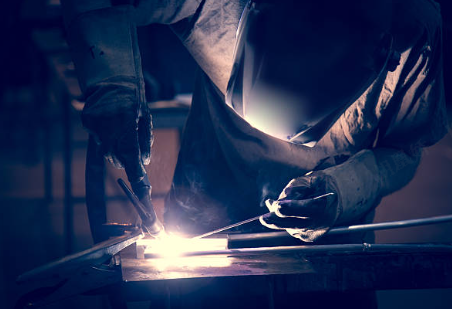TIG welding, or Gas Tungsten Arc Welding (GTAW), is a sophisticated and versatile welding technique that plays a critical role in various industries, particularly in motorsports. This method is renowned for its precision and ability to create strong, high-quality welds, especially on materials like aluminum and chrome-moly steel. In this article, we'll explore how TIG welders operate, when to use them, and tips for mastering the technique. Whether you're a hobbyist or a seasoned professional, understanding the intricacies of TIG welding can enhance your fabrication skills and improve the quality of your work.

I. The Mechanics of TIG Welding
At its core, TIG welding involves using a non-consumable tungsten electrode to generate an electric arc. This arc melts the base material, allowing for the addition of filler material as needed. The process is called “inert gas” welding because it uses an inert gas—most commonly argon—to shield the weld area from contamination. This protective atmosphere is crucial, as it prevents oxidation and other reactions that could weaken the weld.
1)The Role of the Tungsten Electrode:
The tungsten electrode is a key component in TIG welding. Unlike filler rods, the tungsten does not melt away during the welding process. Instead, it maintains its form while providing the necessary heat to melt the base material. Depending on the specific application, the tungsten can be sharpened to a point or shaped into a ball, which affects the arc stability and the heat concentration.
2)Inert Gas Protection:
The inert gas flows through the welding torch and surrounds the weld area, creating a protective barrier. This is akin to the flux coating used in stick welding but offers superior protection against atmospheric contaminants. The choice of gas is vital; argon is the most common due to its effectiveness and availability. However, for specific applications, such as welding magnesium or aluminum alloys, a mixture of argon and helium may be used to increase heat input.
II. Getting Started with TIG Welding
Before diving into TIG welding, it's essential to familiarize yourself with the equipment and setup. Here’s a breakdown of the key components you’ll need:
1)Essential Equipment:
TIG Welder: Choose a quality machine suited to your needs, whether you're welding at home or in a professional setting. Brands like Megmeet-Welding offer a range of products for various skill levels. Go through the Megmeet-welding TIG welding machines list to choose an ideal one.
Tungsten Electrodes: These come in various sizes and types, including pure tungsten and those alloyed with thorium or zirconium. The choice depends on the material you’re welding and the desired arc characteristics.
Filler Rods: Select the appropriate filler material based on the base metals being joined. For aluminum, 4043 and 5356 alloys are common choices, while for steel, you might use ER70S-2 or ER70S-6 rods.
Protective Gear: Safety is paramount in welding. Ensure you have a high-quality welding helmet (preferably auto-darkening), gloves, and protective clothing to shield against sparks and UV radiation.
Gas Supply: You’ll need a gas bottle filled with argon and a regulator to control the gas flow. Setting the regulator at around 20 cubic feet per hour (cfh) is a good starting point.
2) Setting Up Your Welder:
Once you have your equipment ready, it’s time to set up your welder. Here’s a step-by-step guide:
Connect the Work Lead: Attach the ground clamp to your workpiece. This is crucial for completing the electrical circuit.
Install the Tungsten: Insert the tungsten electrode into the torch, adjusting it to protrude about 1/8 inch from the ceramic cup.
Choose the Correct Polarity: For aluminum welding, set your machine to alternating current (AC). For steel, direct current (DC) is typically used.
Turn On the Gas: Open the gas bottle and check for leaks. You should hear the gas flowing when you press the foot pedal.
Practice: Start with some practice pieces of scrap metal to get a feel for the machine and the welding process.
If you are using a tig welding machine for the first time, you can further read How To Setup A TIG Welding Machine For the First Use.
III. Understanding TIG Machine Controls
TIG welders come equipped with various controls that allow you to fine-tune the welding process. Familiarizing yourself with these controls is essential for achieving optimal results.
1) Amperage Control:
Most TIG machines feature a foot-operated variable amperage control. This allows you to set a maximum amperage level and adjust it while welding. The ability to control the heat input is particularly important when working with sensitive materials like chrome-moly steel, which can be prone to thermal shock.
2) Balance Control:
For aluminum welding, balance control is a crucial feature. It adjusts the cleaning action versus the penetration of the weld. A higher balance setting (70-80%) increases penetration, while a lower setting enhances cleaning, which is essential for removing oxides from the surface of aluminum.
3) Pulsed Welding:
Many modern TIG machines offer a pulsed welding mode, which alternates between high and low amperage. This technique can help reduce heat input, minimize distortion, and create a visually appealing weld bead. Pulsed welding is particularly beneficial for thin materials, as it allows for better control over the heat-affected zone. Learn, should I TIG with or without pulse?
IV. Mastering the TIG Welding Technique
Now that you understand the equipment and controls, let’s delve into the actual welding process. Here are some tips to help you get started:
1) Proper Torch Positioning:
Hold the torch at a comfortable angle, usually around 15 to 20 degrees from vertical. This position allows for better visibility of the weld puddle and helps maintain a steady arc length. Keep the tungsten electrode about 1/8 inch above the workpiece to avoid contamination.
2) Feeding the Filler Rod:
With one hand, control the torch while the other hand feeds the filler rod into the molten puddle. The key is to maintain a consistent motion, allowing the filler to melt and mix with the base material. Practice makes perfect, so don’t be discouraged if it takes time to develop a smooth feeding technique.
3) Maintaining the Arc:
The arc length is critical in TIG welding. A short arc (about 1/8 inch) provides better heat concentration, while a longer arc can lead to a cooler weld. If the tungsten touches the workpiece, it can become contaminated, leading to issues with your weld. If this happens, you'll need to remove the tungsten and clean it before continuing.
4) Weld Speed and Travel Angle:
Your travel speed—the rate at which you move the torch—and your travel angle will significantly affect the quality of your weld. Too fast, and you won't allow enough heat to penetrate; too slow, and you risk burning through the material. A good rule of thumb is to move at a steady pace that matches the width of the weld pool, which you should maintain at a consistent size.
Additionally, the travel angle—how you're angled concerning the weld—affects the shape and quality of the bead. Typically, a slight push into the weld direction (about 10-15 degrees) helps create a uniform bead, ensuring proper penetration and a smoother finish.
V. Common TIG Welding Pitfalls
Despite its advantages, TIG welding can be challenging, especially for beginners. Here are some common pitfalls to watch out for:
1) Contaminated Tungsten:
As mentioned earlier, touching the tungsten to the workpiece leads to contamination. This can create erratic arcs and affect the quality of your weld. Always be mindful of the distance between the tungsten and the surface you're welding.
2) Incorrect Filler Rod Size:
Using the wrong size filler rod can lead to issues with the weld. A rod that’s too thick may not melt properly or bond with the base material, while a rod that's too thin may not provide sufficient strength. Choose the appropriate size and type based on the materials you're welding.
3) Puddle Management:
Your ability to control the weld puddle can make or break your weld quality. Practice adjusting the heat up and down, as well as maintaining the right amount of filler metal in the puddle. A good visual cue is to look for a shiny, fluid pool—this indicates optimal conditions for forming a strong weld.
VI. Essential Safety Precautions
Safety should always be a top priority when performing TIG welding. Here are some essential safety tips to follow:
Wear Protective Gear: Invest in high-quality welding gear, including a long-sleeved shirt or coveralls, welding helmet, gloves, and closed-toe leather shoes. This protects against UV exposure, heat, and sparks.
Proper Ventilation: Ensure your workspace is well-ventilated to avoid inhaling harmful fumes produced during welding.
Keep a Fire Extinguisher Nearby: Welding can ignite flammable materials, so keep a fire extinguisher on hand and maintain a clean workspace free of hazards.
Inspect Your Equipment: Before each welding session, check your equipment for leaks and wear. Ensure gas lines are intact, and the welder is in good working condition.
VII. Practicing TIG Welding
To become proficient at TIG welding, practice is essential. Here’s how to build your skills effectively:
1) Work with Scrap Metal:
Start by practicing on pieces of scrap metal before moving on to your actual projects. This will give you the opportunity to adjust settings, practice different techniques, and understand how your machine responds before working on something important.
2) Experiment with Different Settings:
Don’t hesitate to modify the settings on your welder throughout your practice sessions. Adjust the amperage, balance, and gas flow to see how they affect your weld. This hands-on experience is invaluable for understanding the nuances of the process.
3) Take Notes:
Keep a journal of your practice sessions. Document details such as material type, settings, techniques used, and the results. Over time, you’ll identify what works best for you and refine your welding approach.
VIII. Conclusion
TIG welding is a highly skilled technique that can yield exceptional results when mastered. By understanding the principles of the process, practicing regularly with different materials and techniques, and adhering to safety guidelines, you can develop your TIG welding skills significantly over time.
Whether you're using TIG welding for fabricating custom parts for motorsport applications or any other project, the precision and quality of your work will speak volumes. Remember, every expert was once a beginner—embrace the learning process, and don’t be afraid to make mistakes along the way.
Related articles:
1. The Most Complete TIG Welding Basics
2. MIG VS TIG Welding: What are the Differences?
3. Laser Welding vs TIG Welding - What’s the Difference
4. Welding Tips: 6 Secrets of Beautiful TIG Welding
5. AC DC TIG Welding Machine: Unleash Precision with Megmeet




